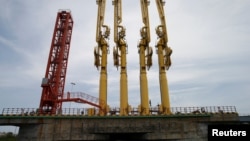Myanmar’s military government has approved resumption of construction of the Chinese-backed Kyaukphyu deep-sea port after years of delay.
The project is a significant step in China’s push to develop an outlet to the Indian Ocean and bypass the Strait of Malacca, a pirate-infested chokepoint on busy trade routes to the Middle East, Africa and Europe.
The State Administration Council and the Chinese state-owned firm CITIC signed the Kyaukphyu deep-sea port deal, a “supplementary agreement,” to a 2014 deal in the final weeks of 2023. Discussions on the $7.3 billion port project and its adjoining $1.3 billion special economic zone began in 2010. Fighting that erupted after the February 1, 2021, military coup and COVID-era restrictions are the most recent causes of delay.
The port’s 242-hectare site is in the western state of Rakhine. The northern part of the state is home to the Rohingya, a Muslim minority group long subjected to discrimination in predominantly Buddhist Myanmar. Rakhine is also known for ongoing conflicts between the regime’s army and the Arakan Army from the Buddhist-majority Rakhine ethnic group.
As one of the 14 nations bordering China, Myanmar holds a unique position in the Belt and Road Initiative, a 10-year-old project to connect the world to China and counter what Beijing sees as the current U.S.-dominated international order.
According to a report by the U.S. Institute of Peace, the Myanmar route to the Indian Ocean will help China counter the regional influence of longtime rival, India and secure its oil and gas transportation routes.
But development of the Kyaukphyu port faces the same challenges bedeviling the rest of the China-Myanmar Economic Corridor, which is part of the BRI — escalating political unrest and armed conflict in Myanmar, according to analysts.
Yun Sun, co-director of the East Asia program and director of the China program at the Stimson Center, told VOA Burmese in a telephone interview that China's primary goal in Myanmar is for the unsettled nation to achieve stability through economic development. This aligns with China's broader strategy of leveraging economic cooperation to foster regional peace and stability, she added.
“I also think that if Myanmar is unstable, it will not be able to be a safe transportation corridor for China anyway," Sun said. "So, I think this goes back to the Chinese argument that peace and development are the two sides of the same coin, that if you want peace, you need to have economics development, and economic development will in turn reinforce peace."
A Burmese expert who spoke to VOA Burmese via Zoom and asked to remain anonymous due to safety concerns said that China's policy regarding large-scale projects such as the China-Laos-Thailand railway has changed.
"China really doesn't get much out of this project compared to their huge billions of dollars of investment," he said.
"In the past, the countries involved in the BRI projects had concerns about debt traps,” he said, but now China faces an investment trap due to the billions dedicated to large-scale BRI projects. This may prompt Beijing to focus on smaller, more manageable projects, he added.
At the October BRI Summit in Beijing, China said “leaner” and “greener” projects would be the future of the global undertaking.
In Myanmar, longtime observers of the BRI projects agree that many of them are at risk from frequent fighting near project sites. The local analyst noted that since the 2021 military coup, many of the projects have stalled.
Sun said that while China’s projects in Myanmar may not be directly threatened, stabilizing stable trade routes through conflict-affected areas remains a concern.
“You still need transportation between China and the port, and that will have to go through the conflict-affected areas in Myanmar,” she said.
Moe Thuzar, a senior fellow at the ISEAS-Yusof Ishak Institute who coordinates the Myanmar Studies program, said public perception of BRI in Myanmar has shifted over time in a report for the Carnegie Endowment.
She said the optimism about the initiative's potential for infrastructure development and regional benefits during the previous Aung San Suu Kyi civilian government is now growing apprehensive about China's economic dominance and political influence, especially after the 2021 coup.
But China's approach is to navigate the current instability with an eye toward future stability and cooperation.
"The Chinese are not looking at tomorrow morning. They're looking at five years later, 10 years later. And the situation will, in the Chinese view, become more stable, and that's when those projects will become useful," said Sun. “They want to see a relatively legitimate government in control so that they don't have to deal with the sporadic conflicts.”
China's long-term vision for its projects in Myanmar reflects a strategic calculation that anticipates eventual stabilization and peace.
The expert in Myanmar told VOA, "I think if the political situation becomes more stable, China will continue to make small-scale projects and investments in Myanmar. At least the railway project to Kyaukphyu sea port can start.”













